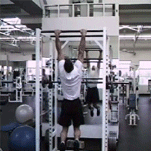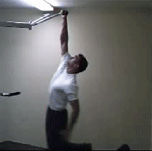 |
| Jorene Downs [CC BY-SA 3.0 (https://creativecommons.org/licenses/by-sa/3.0)] |
Search and rescue teams are trained to find subjects who are lost and get them to the medical interventions that they need. In Virginia, where I volunteer as a ground searcher, there are other teams that train their specialties such as canine and equine search teams.
Say that your heroine has been wandering around lost in the woods for three days. Your hero is frantic! He does the right thing and asks that trained search teams go out and look. Once your heroine is located, the team radios that information to the management team back at base to help make an evacuation plan.
While searchers are trained to give immediate care and stabilization with what they've carried in their packs and what they can MacGyver together, searchers still have to get your character out of her situation and to safety. If possible, transportation is sent in. But, in the search areas where we often operate, this can be difficult.
Ways to evacuate:
- Vehicle
- helicopter
- car/truck
- four wheeler
- boat
- Walk
- Equine (horse)
- Litter carry. (the longest, slowest)
When a subject is missing, management will decide which resources to deploy. These might include K-9, trackers, ground searchers and equine.
If there is an equine team in the field, perhaps they are the team that found your heroine. Or perhaps their proximity is close and management determines your character might be able to be evacuated on horse.
Some reasons why your heroine might have trouble walking out:
- They have blisters
- Twisted ankle
- Exhaustion
The choice of horse rescue:
The team arrives. The equine team has to determine whether or not they feel they can help your heroine evacuate.
She can't be transported on a horse if she has:
- Head injury
- Broken bones
- Back or tail bone injury
- Allergies to the horse
- Fear of the horse
So be careful how you write that scene and just how much you mess her up if you want your heroine to leave on a horse. If she can't ride or walk, and if she isn't going on the horse, they'll have to put her in the litter and no one wants that, least of all your heroine in her diaper. (More about that in a different article)
The choice of which horse:
Typically, our equine teams go out as a two-person team. They know the terrain they're working with, and they know the temperament of the horses they're mounting as well as that horses' temperament on that day and in those conditions. Horses have their moods, too.
Throw your plot a curve ball and give your horses a case of unexpected attitude from thunder or the roar of an approaching fire...
The equine team members will decide, given the situation, whose horse best suits the extraction. Often, it is the smaller of the horses for ease of getting the injured person on to the horse and for the ease of the walkers (flankers).
Getting under way:
- Everyone involved in the evacuation is introduced to the horse. for example: "This is Cali. She's a mare. She doesn't bite or kick. This is her safe zone. Don't go into the other zones." This is important so everyone can stay safe and feel comfortable. The first rule of rescue is don't become another victim that needs to be saved.
- Fit your heroine with a helmet. The helmet chosen is the one that fits best. The rider who has given up their helmet will not be allowed onto a horse without it.
- Move the horse to the side of a hill, a rock, a stump or other feature that would help your heroine to mount the horse. This is directed by the horse's owner.
- Place someone on the opposite side of the horse to protect the subject should they over-do and go sliding off the other side of the horse. This is particularly important if they are getting a leg up.
- Once your heroine is situated in the saddle, the flankers position (side-walker position) themselves on each side of the subject. They reach forward and grasp the saddle and plant their forearm against the subject's leg. This stabilizes her in the stirrups.
- The medic for that group is the left-sided flanker.
- The rescuer who works that horse leads that horse.
- The other rider will typically lead their horse behind the transporting horse, but this may change based on the horses personalities and so it is at the discretion of the teammates. For example, some horses feel safer following.
- The ground team searchers are in front.
If you are writing a scene with a horse who is the subject in distress, you would have your rescuers call in a team that specializes in Technical Large Animal Rescue.
Horses are divided into cold, warm and hot blooded.
Since all horses are mammals and are therefore physiologically warm-blooded, the designations don't initially make sense. These informal terms are used to group different breeds loosely by their temperament. ... Cold-blooded horses encompass the draft breeds such as Percherons, Shires, Clydesdales, and Belgians. Warm-blooded horse breeds were produced by crossing hot-blooded and cold-blooded horses. Many countries developed strains of these horses that could be used for riding or for drawing wagons and carriages. Dutch Warmblood, Hanoverian, Holsteiner, and Trakhener horses are usually calmer than Thoroughbreds, but have the ability to move more athletically than the heavier draft breeds. Warmbloods are often the type of choice for many disciplines dressage, driving, and eventing. Link
For Search and Rescue, while there are examples of hot blooded horses (thoroughbred and Arabians) being successful, a good choice for a Search and Rescue horse is a quarter horse.
I hope that's helpful with writing your scene!
Cheers,
Fiona















